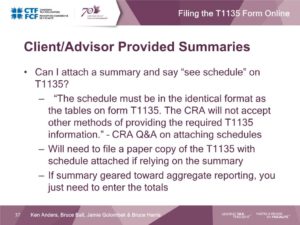 If you’re a Canadian investor with a large taxable foreign portfolio, you need to be aware of your cost base, since exceeding $100,000 of so-called Specified Foreign Property (SFP) has to be reported to the Canada Revenue Agency.
If you’re a Canadian investor with a large taxable foreign portfolio, you need to be aware of your cost base, since exceeding $100,000 of so-called Specified Foreign Property (SFP) has to be reported to the Canada Revenue Agency.
This is examined in my (monthly) High-Net Worth column for the Globe & Mail Report on Business which was published online on Friday and was in the physical paper Wednesday, Nov. 15. You may be able to retrieve it by clicking on the highlighted headline: Pay Close Attention to Your Foreign Assets to Avoid Tax Troubles. (Depending on how often you access the site, access may be restricted to subscribers. I’ve summarized the main points below.)
If you file your own taxes, you may have noticed an innocuous looking “box” you may or may not tick each year that ask whether you own “Specified Foreign Property.” If you have a cost base of more than $100,000 of SPF you have to tick that box and fill out a CRA form called the T1135. For most Canadian investors the relevant investments will probably consist primarily of individual US stocks, ADRs and/or foreign equity ETFs trading on US and other foreign stock exchanges.
There is also a higher threshold of $250,000 you also should be aware of because this entails even more detailed reporting and paperwork, and the article suggests you may wish to avoid reaching that higher threshold. The $100,000 and $200,000 thresholds are per individual, not household, and again, it’s based on cost base not current market value.
Failure to comply can entail serious penalties.
How to stay below the threshold and still have foreign content
If you would rather not deal with more CRA paperwork and capital gains hassles, I’d argue you should try to stay below the $100,000 threshold, in which case you don’t have to tick the box on your tax return.
There is an easy way to avoid this problem, even if you love having foreign content for both diversification purposes and to avoid too-heavy Home Country Bias in our home and native land, and its three-fold concentration in the three sectors of energy, materials and financials.
That is to buy Canadian-domiciled mutual funds or ETFs, even if the underlying securities are US or foreign. It’s generally difficult or impossible to buy foreign-domiciled mutual funds anyway, but many Canadians do own foreign or US equity ETFs trading on US stock exchanges. (I certainly do!). They count as SPF, but if you buy foreign equity ETFs from Canadian ETF companies (like BMO ETFs, Horizons or the Canadian units of BlackRock iShares or Vanguard Canada), then you get around the problem.
So why not exclusively own such ETFs even before you get to the magic $100,000 threshold? Well, many investors may wish to keep costs down by owning individual US stocks or American Depositary Receipts (ADRs). So from my perspective, couples can put $200,000 between them in foreign or US stocks and ADRs, carefully monitoring the cost base as you approach the threshold, and after that restrict new non-registered money to the Canadian-based foreign investments. You can of course hold as much US and foreign stocks in your RRSP as you wish, and there you will encounter no paperwork or capital gains hassles or paperwork, and of course it’s been years since there was a foreign content limit in RRSPs, other registered plans or pensions.



Dear Jonathan,
Do you have any links/blog posts on owning foreign property (specially a house, located in Mexico).
We purchased the property for (way) less than $100,000CDN. I do not know it’s current value. We have no intention of selling in our lifetime, however, plans can change.
We also own no property in Canada (anymore) so would/could our foreign property be considered as our primary residence? Note that we pay taxes in Canada and live here 7 months a year.
Regards, Sarah.